I went outside and did my best to recognize the stars. I did pretty good, and I correctly identified Capella, Aldebaran, Bellatrix, Elnath, Betelgeuse, Rigel, Altair, Deneb, Alberio, Vega, Achernar, Algol, Polaris, Fomalhaut, and Mira. I also saw a lot of constellations, like Ares, Triangulum, Pisces, Perseus, Ursa Minor and Sagitta.
Tuesday, December 20, 2011
Friday, December 9, 2011
APOD 2.6

On december 10th, there will be a lunar eclipse visible from asia to austrailia. In this eclipse, the moon will be inside of the Earth's Umbra for a total of 51 minutes. Those watching in Europe and Africa will however missout on the the partial phases early in the evening, because the eclipse will start before the moon rise for that half of the globe. Those viewing the eclipse in the Americas will be able to see the beginning of the eclipse as the moon sets . The lunar eclipse pictured here was taken in February 2008 over Iran's Zargos Mountains.
Saturday, December 3, 2011
APOD 2.5
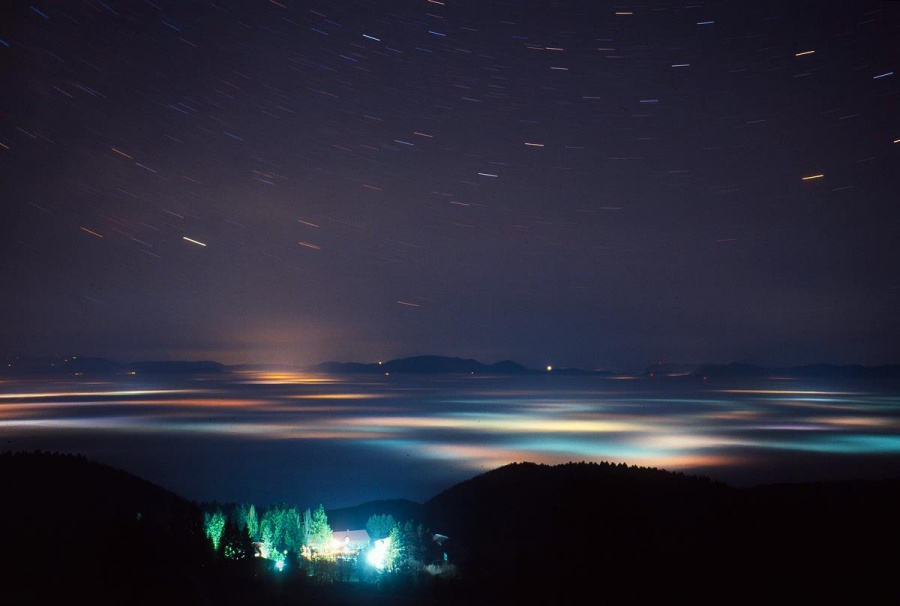
In this long exposure photo, the startrails are captured about a beautiful sea of clouds lit by cities and towns in the valley below. Stars near the celestial north pole can be seen near the top right corner of the image. This long exposure film image can be seen as reminiscent a past age when Europe was covered by the Pannonian Sea.
Sunday, November 27, 2011
APOD 2.4

The Pelican Nebula is an emission nebula that spans 10 light years and forms the shape of a pelicans head. This closeup of the nebula was formed by compiling data from emmission spectra data from sulfur hydrogen and oxygen atoms to red green and blue. The dark regions are cold clouds of dust and gas whose shapes were formed by the radiation of young stars. The two jets erupting from the nebula are signs of proto stars forming in the nebula
Sunday, November 20, 2011
APOD 2.3

This gassy nebula located 6,500 lightyears away towards Cassiopeia, is an area with lots of new star formation. The Dust in this nebula is so thick, that it had to be imaged with infared and scientifically recolored. The red areas are areas of heated gas, while the green and white areas are locations of much higher density. The collision of these different regions of gas form pillars of hot, dense gas; which is prefect for star formation. W5 is shown in this image, and when viewed along side IC 1805 they are called the heart and soul nebula.
Friday, November 11, 2011
APOD 2.2

M83 is a Spiral galaxy 12 million lightyears away, in the Hydra constilation. This compound image was formed by combining images previously found on the Hubble Legacy Archive. The unique combination of dust and young stars in its spirals has led to this galaxy receiving the nickname 'The southern Pinwheel' for its resemblance to a pinwheel. The blue areas are regions of young stars, and the red regions are areas of star formation. Not only is the center full of old stars, but when viewed in the x-ray spectrum it is very bright, which means it is also full of neutron stars and black holes.
APOD 2.1
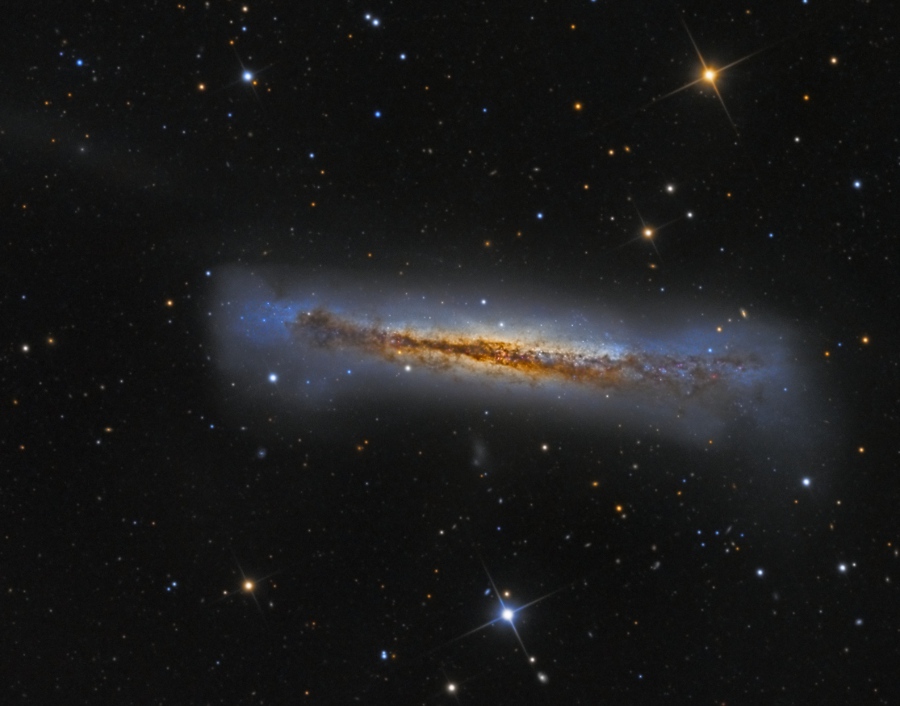
This image is of the NGC 3628 Galaxy is of its side. This galaxy is 35 million light years away. Affectionately referred to as the Hamburger Galaxy, it can be seen in the Leo constellation. The flairs that can be seen at any of the wider points of the galaxy were likely caused by gravitational interaction with other galaxies. The outside portion of this system consists almost entirely of young blue stars, as can be seen by the color of the outermost star cloud. This image was taken using deep space image technologies.
Monday, November 7, 2011
observation 2.1
Went outside for like 6 hours and looked at the sky, saw a lot of stars and constellations aquila pagasus andromida, other near by stuff. triangle. Looked at the sky and found the meaning of life, but i forgot it. I wish there was more to look at in the fall sky, looking forward to the winter sky though! Hopefully it'll be as cool as it is every year!
Monday, October 24, 2011
APOD 1.8 -- Jupiters Clouds
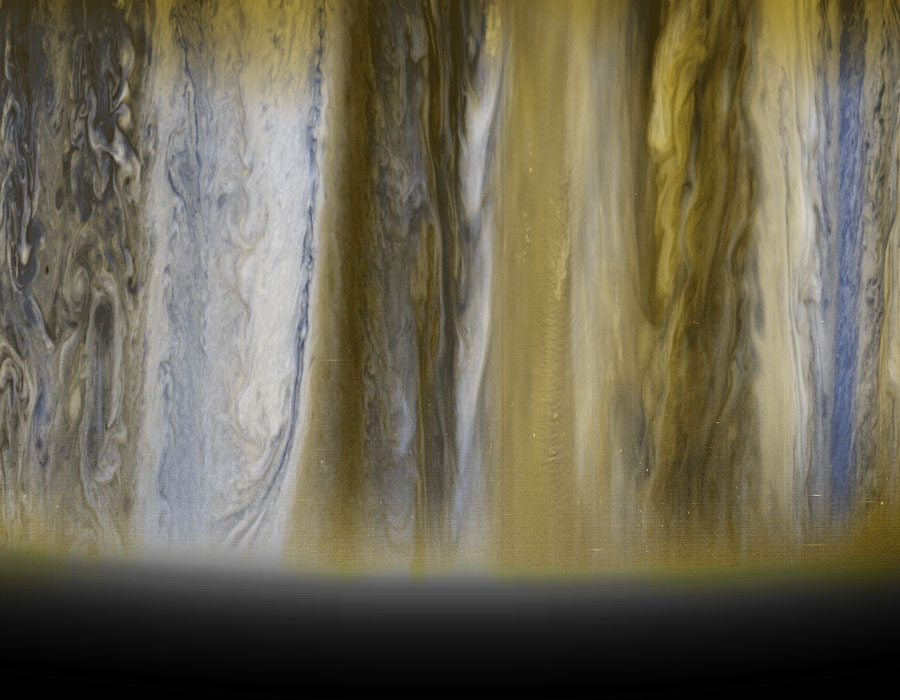
On its journey towards Pluto, the New Horizons spacecraft was able to take beautiful of Jupiter's atmosphere. From this picture, the high speed bands of equatorial clouds are clearly visible in high detail true color where it looks like something out of a Van Gogh painting. The left side of the image is Jupiters south pole. The size of brightness of these bands allow them to be seen with relative ease, even with a small telescope.
Sunday, October 23, 2011
Observation 1.2
Date: 10-23-2011
Time: 8pm - 10pm
Place: Pine View School Astronomy Night
Sky Conditions: clear/light clouds
Instrument Used: Naked Eye, Binoculars, Telesopes
Planets: jupiter
Bright Stars Noted: Altair, Deneb,
Constellations Noted: Summer Triangle
Constellations & Mobjects: Cygnus, Aquila, Andromeda, M11, Sagittarius, Scutum, Hercules/Keystone, Sagitta, Ophiuchus, Jobs Coffin, Vulpecula(location was noted),
Other: New moon
Time: 8pm - 10pm
Place: Pine View School Astronomy Night
Sky Conditions: clear/light clouds
Instrument Used: Naked Eye, Binoculars, Telesopes
Planets: jupiter
Bright Stars Noted: Altair, Deneb,
Constellations Noted: Summer Triangle
Constellations & Mobjects: Cygnus, Aquila, Andromeda, M11, Sagittarius, Scutum, Hercules/Keystone, Sagitta, Ophiuchus, Jobs Coffin, Vulpecula(location was noted),
Other: New moon
Sunday, October 16, 2011
APOD 1.7 -- Transit of Venus

The 2004 transit of Venus was the first of the such event to occur since 1882. It was a very important event as it was used to measure the effect that small rocky planets have on the apparent brightness of a star, as well as to see if the atmosphere of the planets being seen effected the observable dampening of a star. The 2004went over the majority of the countries in the northern hemisphere.The next transit of Venus will occur in 2012, transit occur pairs.
Wednesday, October 12, 2011
Brahmagupta Essay
Brahmagupta wan an Indian astronomer and mathematician born in Bhillamala city, in the state of Rajasthan. Due to the success of his work, in literature of the time he was referred to as the teacher from Bhillamala. Bramagupta was not only and astronomer, but a brilliant mathematician as well. As a mathematician, he was revolutionary for his time as he was the first to compute with 0 and devised rules to work with zero. His mathematical prowess is by no means exaggerated, as he created an ainterpolation formula for calculating the value As well as creating the rules that are used today for doing math with negative numbers. As an astronomer he was one of the first to accurately calculate a year, calculating it to be 365 day, 6 hours and 5 minutes however he was a little off, as the true length of a year is a little under 365 days and 6 hours. He was also extremely interested in the moon, probably because it was the one of only things that could be easily studied with out optical amplification. He studied solar and lunar eclipses and the mechanics of the moons crescent as well
Monday, October 10, 2011
APOD 1.6 -- Galactic Winds
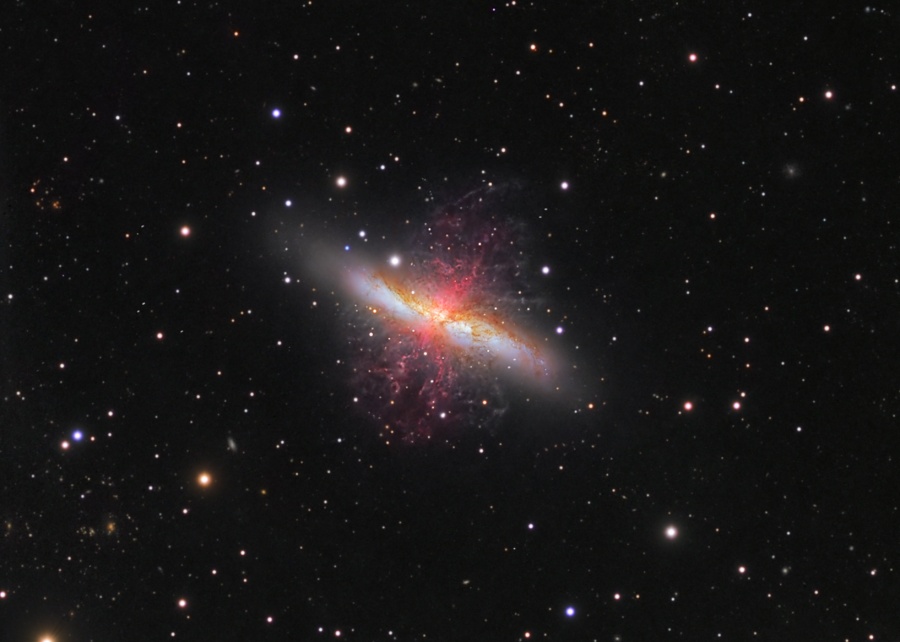
This image of M82 is a starburst galaxy. The large outflow of material from this galaxy old galaxy was caused by the common occurance of supernova, and the winds from large stars. Unlike most sharp images of space objects, this photograph was taken through the composite of many pictures taken by small earthbound telescopes. The Red fingerlings coming off the galaxy are caused by the hydrogen gas emissions, and the abundance of hydrogen in these regions of space are causing a burst of star formation, likely to continue for the next 100 million years. M82 is circumpolar in our region, as it is located in the northern region of Ursa Minor.
Sunday, October 2, 2011
APOD 1.5 -- Start of the Martian Summer
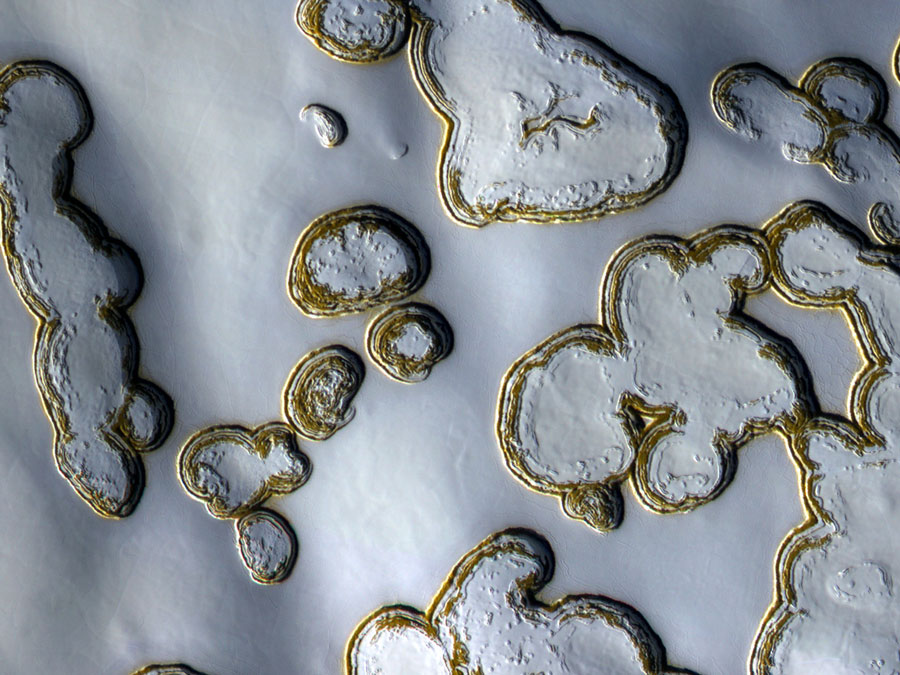
At the end of each Martian summer, the ice on the south pole begins to defrost as the weather gets warmer, causing the dry ice to sublimate into Carbon-Dioxide. The walls of the thawed ices pits are of an unknown composition, and it is likely that they were formed by either water or lava. This image was captured by the Mars Reconnaissance Orbiter, which was launched in 2005 to search for evidence of water on Mars. It took the orbiter 13 months to reach its science orbit at which point its water detection instruments were switched on. Over the next few months, the Martian weather will begin to get colder until the atmosphere again begins to freeze into dry ice.
Saturday, October 1, 2011
Brahmagupta Essay - Bibliography
Gale Reference Library:
Krehbiel, Randy. "Ahead of its time. (An Advanced Society)." Calliope Nov. 2002: 35+. General OneFile. Web. 1 Oct. 2011.
http://go.galegroup.com/ps/i.do?&id=GALE%7CA97388640&v=2.1&u=fl_sarhs&it=r&p=GPS&sw=w
"The curious case of research." Financial Express 18 Apr. 2011. General OneFile. Web. 1 Oct. 2011.
http://go.galegroup.com/ps/i.do?&id=GALE%7CA254234406&v=2.1&u=fl_sarhs&it=r&p=GPS&sw=w
Online:
O'Connor, J J, and E F Robertson. "Brahmagupta Biography." 2000. Web. 01 Oct. 2011. <http://www.gap-system.org/~history/Biographies/Brahmagupta.html>.
Monday, September 26, 2011
APOD 1.4 - September's Aurora
http://apod.nasa.gov/apod/image/1109/C404-5244-6082AuroraTakasaka900.jpg
The aurora are caused by geomagnetic storms. During both the spring and fall the aurora are much more impressive than during summer and fall, though the seasonal connection is not understood. The lights are green, because the light given off by oxygen when it is distressed. The aurora occur approximately 100km above ground level, causing them to be visible from space.
The aurora are caused by geomagnetic storms. During both the spring and fall the aurora are much more impressive than during summer and fall, though the seasonal connection is not understood. The lights are green, because the light given off by oxygen when it is distressed. The aurora occur approximately 100km above ground level, causing them to be visible from space.
Thursday, September 22, 2011
Astronomy Cast - Ep. 229
In 1982 NASA decided that after the Mariner missions, they needed to keep doing Mariner missions. So they started on what would become Cassini, but it was still called Mariner Mark II back then. Its goal was to be the first probe to examine Saturn and its moons up close for a long period of time, as the other probes that flew by, Pioneer and Voyager had only flown by. Launching in 1997 with a total build price of 3.26 billion dollars, Cassini was more than ready to do its job, and to do it right. Due to its small engines, Cassini was not lucky enough to be able to take a direct route to Saturn. Using Venus and Earth for multiple gravitational assists and eventually flew by Jupiter on its way to Saturn. Most of the Pictures you see of Jupiter were taken by the Cassini craft. On the 4th of July 2004, NASA was able to put Cassini into Orbit around Saturn. Once it arrived Cassini also launched the Huygens craft into Titans atmosphere to do research.
Tuesday, September 20, 2011
Observation 1.1
Date: 9-19-2011
Time: 10pm - 11pm
Place: Osprey
Sky Conditions: clear
Instrument Used: Naked Eye
Planets: jupiter - near moon
Bright Stars Noted: Altair
Constellations Noted: Triangle
Constellations: Big Dipper, Aquila, i could see the brightest stars in Lyra and Cygnus but could not make out the rest of the constilations
Other: The moon is in 3rd quarter
Time: 10pm - 11pm
Place: Osprey
Sky Conditions: clear
Instrument Used: Naked Eye
Planets: jupiter - near moon
Bright Stars Noted: Altair
Constellations Noted: Triangle
Constellations: Big Dipper, Aquila, i could see the brightest stars in Lyra and Cygnus but could not make out the rest of the constilations
Other: The moon is in 3rd quarter
Monday, September 19, 2011
APOD 1.3 - Galaxy in a Bubble
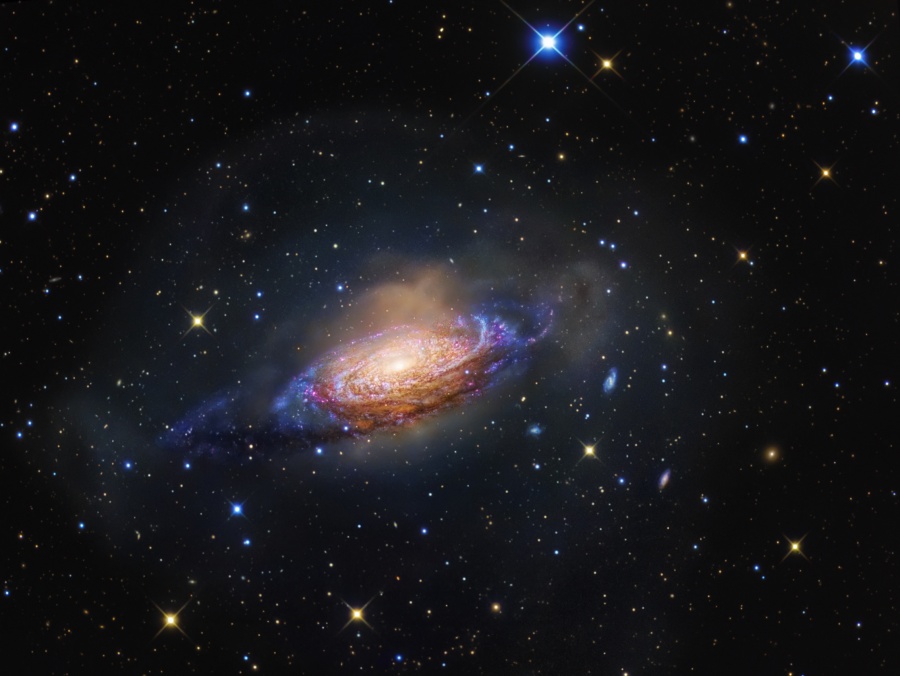
This galaxy(NGC 3521) spans 50,000 light years and it forms a loose and irregular spiral pattern. The stars on the edge of the galaxy form loose bands, this is a result of the merger with NGC 352. Scientists were able to tell these two galaxies collided at one point in time, because the debris shells on the outskirts of the galaxy often denote a collision with a satellite galaxy.
Thursday, September 15, 2011
Observations 1.2
Date: 9-15-2011
Time: 11pm - 12am
Place: Osprey
Sky Conditions: slightly cloudy
Instrument Used: Naked Eye
Bright Stars Noted: Altair, Anteres
Constellations Noted: Triangle
Constellations: With the moon gone it was easy to see dark stars apart from the clouds. Visible were the Big Dipper, Aquila, i could see the brightest stars in Lyra and Cygnus but could not make out the rest of the constellations. Scorpius and Sagittarius were also visible.
Other: The moon is a waning crescent
Time: 11pm - 12am
Place: Osprey
Sky Conditions: slightly cloudy
Instrument Used: Naked Eye
Bright Stars Noted: Altair, Anteres
Constellations Noted: Triangle
Constellations: With the moon gone it was easy to see dark stars apart from the clouds. Visible were the Big Dipper, Aquila, i could see the brightest stars in Lyra and Cygnus but could not make out the rest of the constellations. Scorpius and Sagittarius were also visible.
Other: The moon is a waning crescent
Sunday, September 11, 2011
APOD 1.2
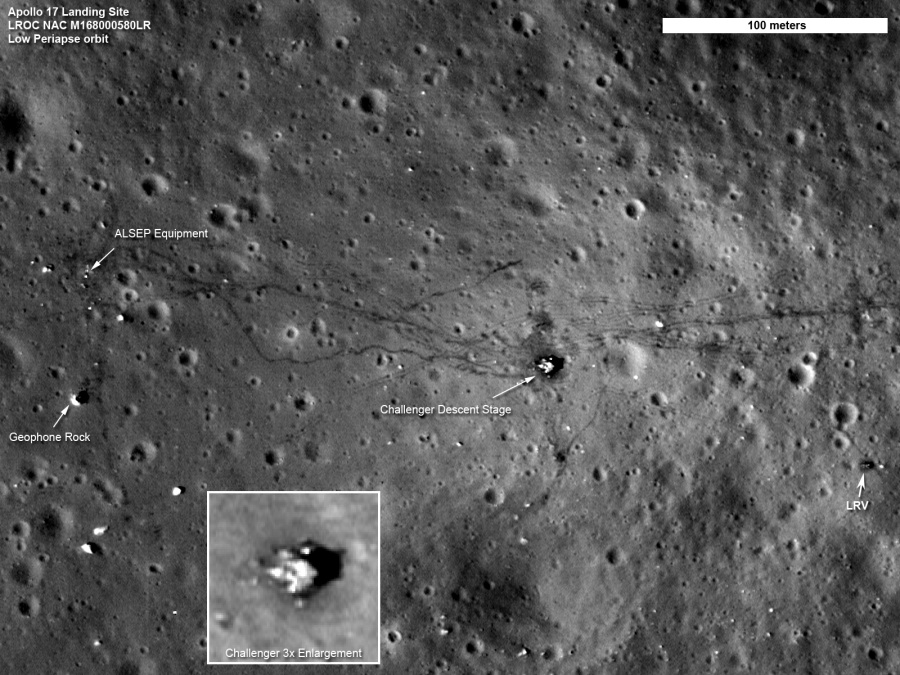
This image of the Apollo 17 landing site is the sharpest image of the moon ever taken from space. With the previous best taken by the Hubble telescope, but it could only focus on things 80m in diameter or larger. To take the picture, they adjusted the orbit of a lunar satellite to be withing 22km of the surface. Tracks heading towards and away from the the landing site were made by the lunar rover as the astronauts explored the moon's surface. Not since apollo 17 have we gotten such a clear picture of the surface of the moon. The tracks are still visible today, because there are few elements to disturb the lunar soil or regolith, which will mean these tracks, and even the foot prints of the astronauts will likely still be visible for thousands of years.
Friday, September 2, 2011
APOD 1.1 - Cool Nebulas
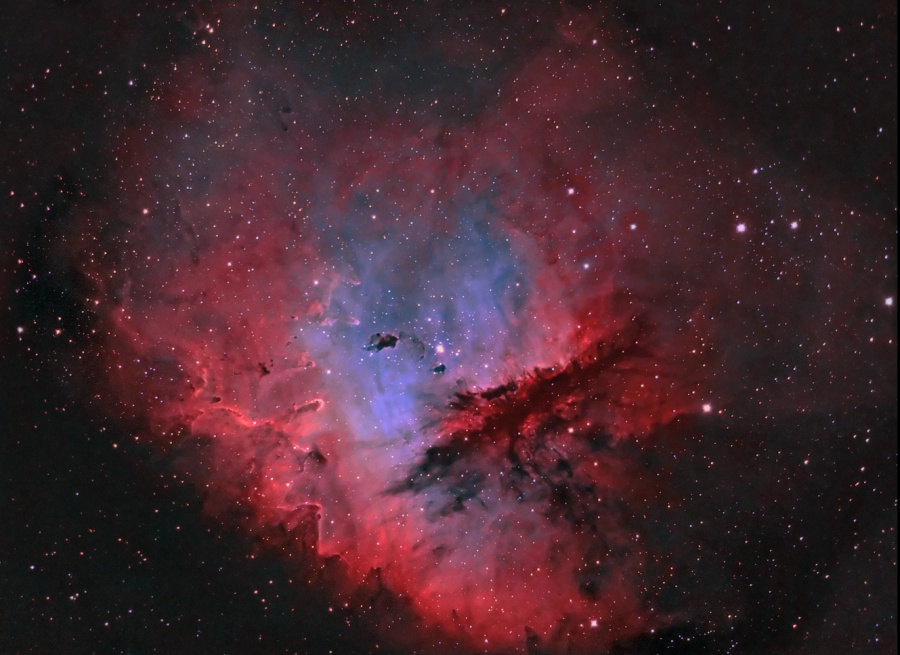
This picture of a young nebula is the host of many young stars and solar systems. Commonly referred to as the Pacman Nebula, it is probably one of the coolest nebula in the galaxy. Unlike some space pictures, this picture was taken using a composite of narrow bands of visible light. The holes in the nebula are places of star formation.
Subscribe to:
Posts (Atom)